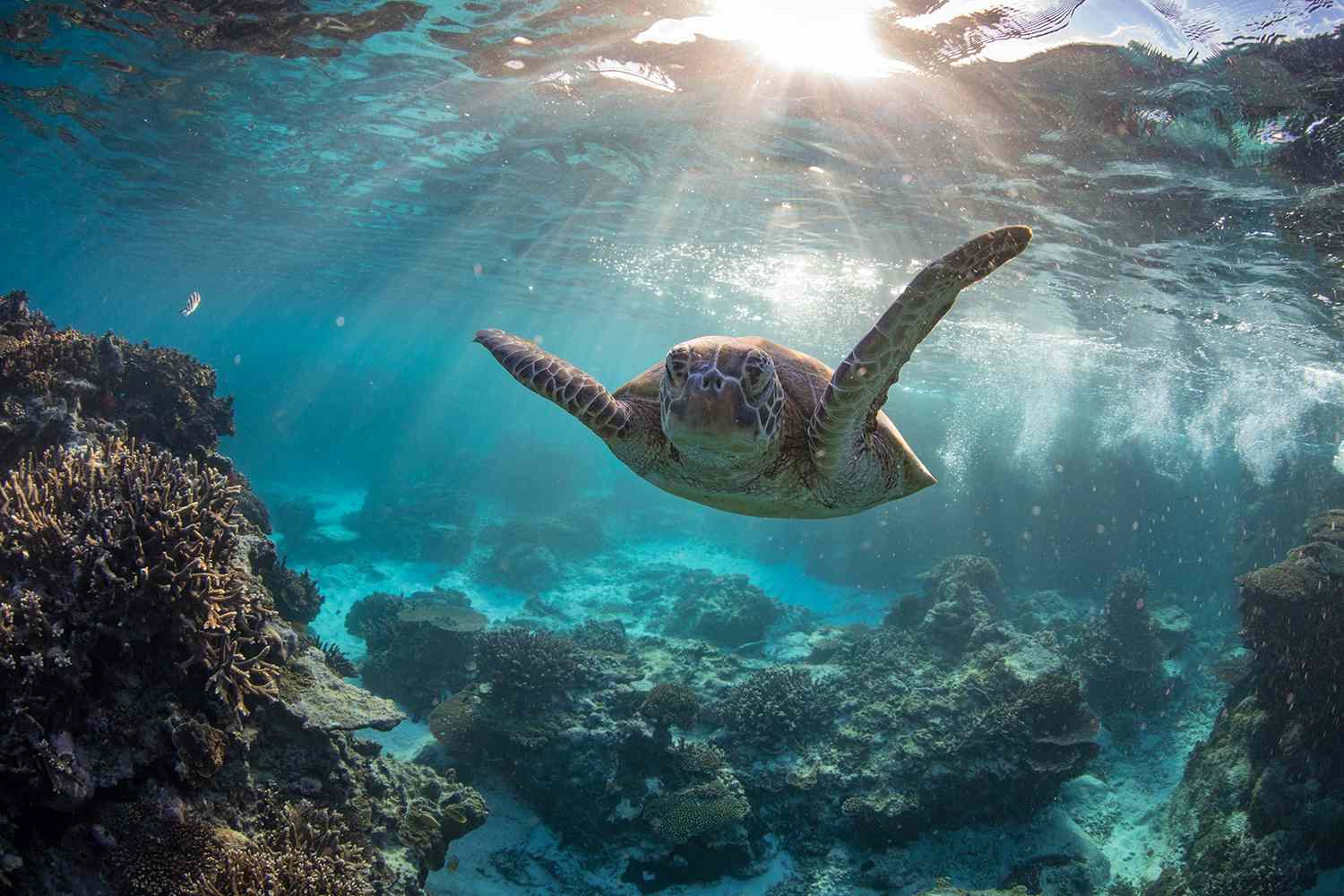With oceans covering more than 70 percent of the Earth’s surface, it’s no surprise that they contain innumerable places to explore. But to find some of the best scuba diving spots in the world at accessible limits for recreational fun, you have to know where to look — you’ll also need to be certified to dive, and PADI can help with that. From vibrant coral reefs teeming with fish to spooky shipwrecks in the Pacific, here’s where to find some of the world’s best scuba diving destinations.
Tuamotu Archipelago, French Polynesia
Stephen Frink / Getty Images
While most honeymooners stick to snorkeling among the rays and reef sharks near their overwater bungalows in Bora Bora and Moorea, adventurous certified divers know the Tuamotu Archipelago is the place to go for the biggest underwater thrills in French Polynesia. Here, in atoll passages near Fakarava (part of the UNESCO Biosphere Reserve) Rangiroa, and Tikehau, some of the best scuba diving spots in the world await.
What kinds of wildlife might you see? Walls of hundreds of gray reef sharks on an excursion with O2 Fakarava, huge manta rays on a Tikehau Ocean Tour, and wild dolphins with the Rangiroa Diving Center, to name a few. Epic doesn’t even begin to describe the diving scene here.
Palau, Oceania
Westend61 / Getty Images
Snorkelers may know Palau for its famous Jellyfish Lake, but divers travel to this remote outpost of the postcard-perfect Micronesia islands for scuba diving within a shark sanctuary. Famous dive sites like the German Channel (a magnet for manta rays) and Ulong Channel, one of the most exciting drift dives on the planet, are among the highlights.
Paddling Palau is a great option for those who want to explore less-visited sites in the Rock Islands. Sam’s Tours and Fish ’n Fins are two of the longest-running dive shops in Palau, offering speedy access to the area’s most iconic dive site, Blue Corner. The sheer abundance of marine life there — including sharks, huge schools of fish, and rays — has been likened to an underwater Serengeti.
Raja Ampat Islands, Indonesia
Giordano Cipriani / Getty Images
From Bali and Lombok to Sulawesi and Komodo, Indonesia is a scuba diving epicenter, and there’s no place on the planet like Raja Ampat in West Papua. The remote region’s dive sites feature pristine coral gardens, teeming fish life, and majestic karst landscapes surrounded by turquoise seas.
The Misool private island resort is a spectacular place to stay, with coral reefs at your bungalow’s doorstep, while the Meridian Adventure Dive Resort offers incredible homestay and boutique hotel accommodations that cater to divers. If you’d rather explore Raja Ampat’s wonders from a liveaboard dive boat — where you sleep onboard, dive, eat, and repeat to get in as much underwater time as possible — Damai and Arenui, each traditional Indonesian pinisi boats, are your best options. If you’re looking to dive and explore the area in luxury, Aqua Expeditions is another great choice for something more yacht-like.
Maldives
Michele Westmorland / Getty Images
The Maldives dish up some of the best scuba dives in the world, whether you stay in an overwater villa at a luxury resort like the Hilton Maldives Amingiri Resort & Spa or prefer a luxe experience at sea aboard the incredible liveaboard dive boat, Scubaspa. In go-to spots around the North Male Atoll, Baa Atoll, Hanifaru Bay, and Ari Atoll, among others, keep an eye out for manta rays, whale sharks, and reef sharks (oh my!), all in the diving mix.
Azores, Portugal
Gerard Soury / Getty Images
The Azores make up a magnificent volcanic archipelago, which is part of Portugal and lies about 950 miles off the mainland, surrounded by ocean and not much else. So, it’s no surprise that some seriously awesome diving can be found here. Portugal Dive can arrange land-based expeditions from islands such as Terceira, Pico, and São Miguel. Another great option is to sail aboard the beautiful Water & Wind catamaran to dive among whale sharks, rays, and other ocean wonders.
Tobago
Stephen Frink / Getty Images
When it comes to Caribbean diving, few islands can offer the excitement of Tobago, known for its drift dives and prolific marine life that includes a mix of Caribbean and South American species. In-the-know scuba divers have this tropical island on their radar as the place to see one of the world’s largest brain corals at the Coral Gardens dive site. Head out with the local dive team from Tobago Dive Experience to peek underwater at places like the Japanese Gardens, full of huge healthy corals and fans, as well as more remote areas around Saint Giles, where you may be able to see scalloped hammerheads.
Galápagos Islands
Michele Westmorland / Getty Images
Despite the collapse of the famous Darwin’s Arch rock formation in 2021, some of the best scuba diving in the world still awaits in the waters just beneath this iconic spot in the Galápagos Islands. Scuba divers who love being in the water with big animals and don’t mind brisk water temperatures — which can sometimes drop into the 60s — should try liveaboard dive boats like the Galápagos Sky and the Calipso yacht. That way, you’ll get to see marine life including endemic marine iguanas, penguins, sunfish, Galápagos sharks, whale sharks, silky sharks, schooling hammerheads, manta rays, and so much more.
Cocos Island, Costa Rica
Rodrigo Friscione / Getty Images
Cocos Island is situated about 340 miles off Costa Rica’s Pacific coast and is well worth the effort. The only way to reach this remote spot is via a liveaboard scuba diving boat like the Cocos Island Aggressor or the Okeanos Aggressor II, each of which departs from the mainland city of Puntarenas for the 36-hour trip. Once you arrive at the dive site, the chance to see schooling hammerheads, manta rays, whale sharks, and other pelagic fish in large numbers makes the long journey worthwhile.
Socorro and Revillagigedo Islands, Mexico
Romona Robbins Photography / Getty Images
It’s another long trip by liveaboard diving vessel to reach these remote islands that belong to Mexico. The neighboring volcanic isles of Socorro and the Revillagigedo Islands lie roughly 250 miles off the southern tip of the Baja California Peninsula, with plankton-rich waters all around that attract large ocean-going animals like manta rays, silky sharks, humpback whales, and bottlenose dolphins. Top liveaboard operators that regularly visit the region include Pacific Fleet and Nautilus Dive Adventures.
Baja California Sur, Mexico
Wildestanimal / Getty Images
For spectacular land-based diving in the Sea of Cortez and the Pacific Ocean off the Baja California Peninsula, head to Baja California Sur. Here, you can dive with sea lions and go whale watching around Cabo San Lucas with Dive Ninja Expeditions, get in the water with whale sharks in La Paz with Red Travel Mexico, and perhaps even spot blue whales in the waters around Loreto with Blue Nation, another top dive shop in the region. There’s a reason Jacques Cousteau once called the Sea of Cortez “the world’s aquarium,” and until you head underwater to see it for yourself, you’ll never know.
The Bahamas
Stephen Frink / Getty Images
It’s hard to find waters more gin-clear than those around the beautiful Bahamas. From wreck dives off New Providence Island and shark encounters by Grand Bahama’s famous Tiger Beach to the spectacular reefs of the Exumas, there’s no shortage of excellent dive spots here. The best part? Diving in the Bahamas can be as much of a splurge as you like. For the ultimate upscale experience, the private charter Motor Yacht Loon offers top-notch onboard facilities and a luxury tender to carry you and your entourage from the mothership to the best dive sites in the Bahamas and beyond (November through April). For something more shoestring, Blackbeard’s Cruises is a low-frills liveaboard that promises lots of camaraderie and tons of time underwater, too.
The Florida Keys, United States
Stephen Frink / Getty Images
To dive along North America’s only coral barrier reef, all you have to do is drive south of Miami to the Florida Keys and get in the water. Pop into one of the many dive shops along the Overseas Highway and set out to explore the nine shipwrecks along the Florida Keys Wreck Trek (if you can’t do all of them, don’t miss the Spiegel Grove, Eagle, and Vandenberg wrecks, located off Key Largo, Islamorada, and Key West, respectively). The miles and miles of glorious coral reefs are home to everything from parrot fish, nurse sharks, and sea turtles to tarpon and barracuda. There are many experienced dive shops in these parts, but among the best are Horizon Divers, the Islamorada Dive Center, and Captain Hook’s.
Poor Knights Islands, New Zealand
Julian Gunther / Getty Images
Scuba diving might not be what first comes to mind when you think of New Zealand. But a few hours north of Auckland on the North Island, some of the Southern Hemisphere’s best subtropical diving awaits just off the town of Tutukaka in the Poor Knights Islands Marine Reserve. Head out on day trips by boat with Dive! Tutukaka to popular spots like the Blue Maomao Arch, which Jacques Cousteau once named among the top 10 dive sites in the world. You’ll swim among the eponymous schooling blue maomao fish, moray eels, and countless other creatures, including tiny colorful sea slugs called nudibranchs that dazzle like sunken treasure. January brings migratory whales to these waters, too.
Fiji
Jason Edwards / Getty Images
The sublime colors of Fiji’s prolific soft corals range from pinks, yellows, and blues to oranges and pale purples. And when you add incredible marine life to that beautiful backdrop at dive sites around Viti Levu, Vanua Levu, Taveuni, and the Yasawa Islands, you have all the makings of the best scuba diving in the world. Fiji is a great place for a family vacation, with most resorts — such as Vomo Island Fiji, the Jean-Michel Cousteau Resort Fiji, and the Six Senses Fiji on Malolo Island — offering top-notch dining and spas as well as on-site dive shops. Seahorses, triggerfish, turtles, and clownfish are among Fiji’s usual coral reef suspects. If you want to dive with sharks, head out on a dive with the Beqa Lagoon Resort for the chance to see several different species, including lemon sharks, whitetip reef sharks, blacktip reef sharks, and bull sharks, among others.
Heron Island, Australia
Colin Baker / Getty Images
Australia’s Great Barrier Reef is the obvious pick when it comes to scuba diving Down Under. And while most travelers gravitate to Cairns for day trips to dive on the most famous site in the world, for something truly spectacular, put the coral reefs of Heron Island on your radar. Located in a more remote stretch of the Great Barrier Reef, you can reach it via boat trips or a helicopter ride from the town of Gladstone, located about a six-hour drive north of Brisbane. There are over 20 dive sites around Heron Island, where you’re likely to see three of the six sea turtle species that exist on the Great Barrier Reef as well as white-spotted eagle rays, lemon sharks, and, from May to September, perhaps even migrating humpback whales.
Chuuk Lagoon, Micronesia
Stuart Westmorland / Getty Images
For divers, there is perhaps no more storied place for World War II-era wrecks than in the tropical, fish-filled waters of Chuuk Lagoon in Micronesia. The best way to see it all over the course of a dive vacation here is to book a berth aboard the Odyssey liveaboard, which takes up to 16 guests down to Japanese wrecks such as the Shinkoku Maru and San Francisco Maru. Many lives were lost in these wartime vessels, and you can feel the human tragedy underwater when spotting things like utensils and clothing that were once used by the crew. Marine life, however, proliferates on the rusting wrecks, which are completely carpeted in hard and soft corals and vibrate with tropical fish.
Red Sea, Egypt
Georgette Douwma / Getty Images
From desert outposts like Dahab and Sharm el Sheikh on the Sinai Peninsula to the waters off Hurghada, Egypt offers some truly incredible scuba diving sites. Awesome Adventures makes it easy to combine the famous sites in Cairo (including pyramids and temples) with shore-based scuba diving expeditions from the mainland and a liveaboard diving option in the Red Sea. Shipwrecks like the legendary British cargo steamship, the SS Thistlegorm, as well as abundant shark life and colorful coral reefs all make diving in the Red Sea well worth the trip.
Tubbataha Reef Marine Park, Philippines
Giordano Cipriani / Getty Images
At the center of the Coral Triangle, the waters of the Philippines harbor some of the best scuba diving spots in the world. To see more turtles, rays, and sharks than you ever imagined all in one place during incredible reef and drift dives, Tubbataha Reef Marine Park, located in the Sulu Sea near the westernmost province of Palawan, makes for an extraordinary adventure. Visit the region via liveaboard on a dive trip on the All Star Infiniti, which departs from Puerto Princesa, a pretty spectacular destination on its own.
The Cayman Islands
Extreme-Photographer / Getty Images
A Caribbean favorite for easy, fish-filled diving, the Cayman Islands delight divers with colorful coral reefs and accessible wrecks that lie close to shore — such as the USS Kittiwake, which snorkelers can explore, too. You can plan a dive trip to the islands on a liveaboard like the Cayman Aggressor IV or make your base on land at a dive-focused resort like Sunset House or Cobalt Coast. During the summer months, schools of thousands of silversides (two-inch-long fish that amass to dazzling effect) appear on the islands’ walls and shallow reefs. It’s a truly remarkable underwater sight.
The Great Blue Hole, Belize
DNY59 / Getty Images
Located about 43 miles off the coast of Belize City, the Great Blue Hole is a natural sinkhole that was created anywhere from 25,000 to 150,000 years ago (experts’ estimates vary). At 1,000 feet wide and 400 feet deep, it was once named by Jacques Cousteau as one of the best diving sites on earth. Depending on your starting point in Belize, it can take about three or four hours to reach by boat, though liveaboard sailings and air tours are also popular options. Those traveling on a budget should check out the reasonably priced full-day diving excursions offered by the Amigos del Mar Dive Shop in San Pedro. For a truly luxe diving experience, consider signing up for a charter package through Belize Sailing Vacations.










